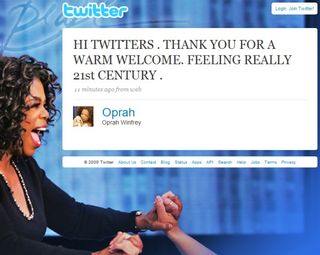About three months ago, I wrote an article about Twitter, and the potential it has to change the way we collect and catalog information as a society. At the time, Twitter was growing quite rapidly, and it was difficult to tell where the trajectory was leading.
I just ran across some interesting research that may give us some insight into this question. The research was conducted by HubSpot, an internet marketing firm based in Boston. Hubspot found that of those who sign up for Twitter accounts…
- 54.88% have never tweeted (i.e. have never posted anything)
- 55.50% are not following anyone (i.e. are not reading anyone else’s posts)
- 52.71% have no followers (i.e. no one is reading their posts)
 What does this mean? Most people who sign-up for Twitter, never use it! It is difficult for a service, such as Twitter, to have a substantial impact if the majority of the subscribers are not using it. This is similar to a bunch of people buying their parents a fax machine in the ’80s—great idea, but nobody could get their parents to actually use it.
What does this mean? Most people who sign-up for Twitter, never use it! It is difficult for a service, such as Twitter, to have a substantial impact if the majority of the subscribers are not using it. This is similar to a bunch of people buying their parents a fax machine in the ’80s—great idea, but nobody could get their parents to actually use it.
The hope of the business world, is that Twitter will become a vast database of information that will allow marketers—recruiters included—to tap into the demographics and preferences of millions of individuals. The HubSpot research uncovered some disappointments there as well:
- 75.86% of users have not entered a bio in their profile
- 68.68% have not specified a location
It’s tough to draw conclusions from a data source that is so limited. The only available information are the millions of 140-character “tweets.” Maybe the FBI could make some sense of this type of disconnected information, but the rest of us remain at a loss.
There is much more data becoming available that can give us clues about the reality of Twitter. For example, a recent study by PMN documented that only 22% of Generation Y consumers (18 – 24 years old) are using Twitter (99% have active accounts on a social networking site, such as Facebook).
You’d think more of this demographic would be driving the buzz about this network, but that is not the case. We do know that 56% of executives under the age of 40, regularly tweet or generate microfeeds (source: ClickZ study, June 09). Do you think anyone is reading them? Probably not.
I think there are a couple of points a recruiter or hiring manager can take from this discussion:
- If you’re feeling an overwhelming amount of guilt because you’re just not connected with the concept of Twitter, this should relieve your guilt. You’re not the only one that doesn’t “get” Twitter—many of your candidates are in the same boat.
- Don’t expect a tool, such as Twitter, to release you from the hard work of recruiting. It would be great to publish something and then have thousands of people lap it up and find you endearing (isn’t that why Oprah tweets?). But, it usually doesn’t that work way. Make the calls, send the emails, have the one-on-one conversations, etc. Twitter may help you in some small way, but the traditional tasks of recruiting will continue to produce the most consistent results.

